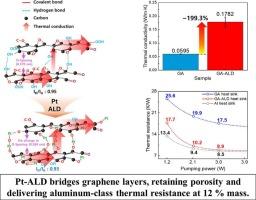超轻pt - ald修饰的石墨烯气凝胶在12%质量下实现铝级热阻
IF 7.9
2区 材料科学
Q1 MATERIALS SCIENCE, MULTIDISCIPLINARY
引用次数: 0
摘要
石墨烯气凝胶(GAs)是一种三维多孔结构材料,它面临着一个基本的挑战:由于组成层之间的高界面电阻和结构缺陷而导致的低导热性。本研究系统地研究了一种通过铂原子层沉积(Pt-ALD)来提高层间键合的策略,并将其与传统的高温退火(1873 K)进行了比较。经pt - ald修饰的石墨烯气凝胶(GA-ALD)的导热系数提高了199%,大大超过了热处理后的113%。SEM, Raman, XRD, XPS和FTIR数据明确表明,Pt-ALD形成共价的PtOC键,桥接相邻的石墨烯层,同时保持原始的多孔形态。由于增强的固相导热系数和通过保留的多孔结构进行的有效对流传热的协同效应,GA-ALD样品在相同的强制对流条件下获得了与等尺寸铝散热器相当的总热阻,而重量仅为铝散热器的12%。此外,循环压缩试验证实了GA-ALD的耐久性,在1000次循环后保持99.5%的高度和94.7%的应力。这些发现表明,通过ALD进行界面键工程是实现重量敏感热管理应用的超轻、高性能碳气凝胶的有力途径。本文章由计算机程序翻译,如有差异,请以英文原文为准。

Ultralight Pt-ALD-modified graphene aerogel achieving aluminum-class thermal resistance at 12% mass
Graphene aerogels (GAs), a class of three-dimensional porous structures, are limited by a fundamental challenge: low thermal conductivity stemming from high interfacial resistance between constituent layers and structural defects. This study systematically investigates a strategy to enhance thermal transport properties by engineering the interlayer bonding via platinum atomic layer deposition (Pt-ALD) and compares it with conventional high-temperature annealing (1873 K). The Pt-ALD-modified graphene aerogel (GA-ALD) exhibited a 199 % increase in thermal conductivity, significantly surpassing the 113 % enhancement from heat treatment. SEM, Raman, XRD, XPS, and FTIR data explicitly indicate that Pt-ALD forms covalent Pt![]() O
O![]() C bonds that bridge adjacent graphene layers while preserving the original porous morphology. Owing to the synergistic effect of enhanced solid-phase thermal conductivity and efficient convective heat transfer through the preserved porous structure, the GA-ALD sample achieved a total thermal resistance comparable to that of an equal-sized aluminum heat sink under identical forced-convection conditions, while weighing only ∼12 % of its aluminum counterpart. Moreover, cyclic compressive tests confirmed GA-ALD durability, retaining 99.5 % height and 94.7 % stress after 1000 cycles. These findings demonstrate that interfacial bond engineering via ALD is a powerful route to ultralight, high-performance carbon aerogels for weight-sensitive thermal-management applications.
C bonds that bridge adjacent graphene layers while preserving the original porous morphology. Owing to the synergistic effect of enhanced solid-phase thermal conductivity and efficient convective heat transfer through the preserved porous structure, the GA-ALD sample achieved a total thermal resistance comparable to that of an equal-sized aluminum heat sink under identical forced-convection conditions, while weighing only ∼12 % of its aluminum counterpart. Moreover, cyclic compressive tests confirmed GA-ALD durability, retaining 99.5 % height and 94.7 % stress after 1000 cycles. These findings demonstrate that interfacial bond engineering via ALD is a powerful route to ultralight, high-performance carbon aerogels for weight-sensitive thermal-management applications.
求助全文
通过发布文献求助,成功后即可免费获取论文全文。
去求助
来源期刊

Materials & Design
Engineering-Mechanical Engineering
CiteScore
14.30
自引率
7.10%
发文量
1028
审稿时长
85 days
期刊介绍:
Materials and Design is a multi-disciplinary journal that publishes original research reports, review articles, and express communications. The journal focuses on studying the structure and properties of inorganic and organic materials, advancements in synthesis, processing, characterization, and testing, the design of materials and engineering systems, and their applications in technology. It aims to bring together various aspects of materials science, engineering, physics, and chemistry.
The journal explores themes ranging from materials to design and aims to reveal the connections between natural and artificial materials, as well as experiment and modeling. Manuscripts submitted to Materials and Design should contain elements of discovery and surprise, as they often contribute new insights into the architecture and function of matter.
 求助内容:
求助内容: 应助结果提醒方式:
应助结果提醒方式:


